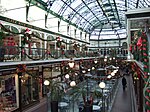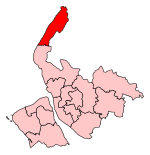Southport War Memorial
British military memorials and cemeteriesBuildings and structures completed in 1923Buildings and structures in MerseysideGrade II* listed buildings in MerseysideGrade II* listed monuments and memorials ... and 2 more
World War II memorials in EnglandWorld War I memorials in England

Southport War Memorial is in London Square, Lord Street, Southport, Merseyside, England. It consists of an obelisk flanked by two colonnades in the form of Greek temples. Outside the colonnades are memorial gardens, each containing a Pool of Remembrance and fountains. The memorial was designed by the local architects Grayson and Barnish, and the carving was executed by Herbert Tyson Smith. It was unveiled in 1923 by the Earl of Derby. Following the Second World War and subsequent conflicts further inscriptions and names have been added. The memorial is recorded in the National Heritage List for England as a designated Grade II* listed building.
Excerpt from the Wikipedia article Southport War Memorial (License: CC BY-SA 3.0, Authors, Images).Southport War Memorial
London Square,
Geographical coordinates (GPS) Address Nearby Places Show on map
Geographical coordinates (GPS)
| Latitude | Longitude |
|---|---|
| N 53.6487 ° | E -3.0044 ° |
Address
The Cenotaph
London Square
PR8 1AA
England, United Kingdom
Open on Google Maps










